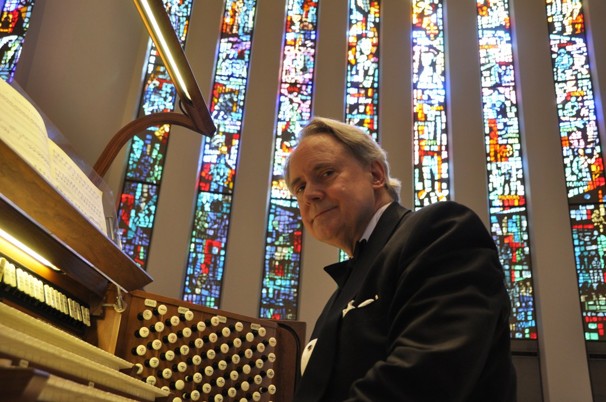In the late summer of 1994, twenty-two years ago, I was recently graduated from the University of Virginia and desperately missed singing. I had sung in the Virginia Glee Club for four years and hoped that I could find a similar experience in a chorus in Washington DC. I didn’t find something similar, but I did find J. Reilly Lewis.
Several other Glee Club members had sung in Reilly’s Cathedral Choral Society and spoke highly of it. I had fond memories of the National Cathedral from a young chorister’s field trip when I was in elementary school. It seemed like a good idea. A few weeks later, I was frantically studying my score on the Metro and wondering if I had lost my mind.
You see, I had been exposed to comparatively unusual repertoire as a Glee Club member: lots of Renaissance and medieval music, some modern works (my lifelong love of Arvo Pärt’s music dates to the 1992 Tour of the South), spirituals and Virginia football songs. But very little of the symphonic repertoire for chorus. We had sung a few works in collaboration with other choruses: Mahler 2, the Fauré Requiem, the Duruflé Requiem, and Orff’s Carmina Burana. But that was about it.
So imagine my surprise when the first piece we sang was Beethoven’s Missa Solemnis, a challenging work even for mature singers, much less someone straight out of college. Piling on the difficulty, I had spent the summer unconsciously stretching my range, singing along to a lot of female singers (Tori Amos and Shannon Worrell among them). So when I auditioned for Reilly he cast me as a first tenor, not the second I had sung since high school. Suffice it to say I was in over my head.
But I loved it. And I loved singing with Reilly. And that made up for a lot.
Reilly was a musician’s musician. Unlike many conductors I’ve sung with since, he had a keen appreciation for the possibilities and limits of the human voice. He liked to lead us in a warmup borrowed from Robert Shaw in which we sustained a four or eight part chord on a neutral vowel, then shifted to a bright “ah” and heard the harmonic overtones bloom forth in the resonant acoustic of the Cathedral. He led us in other Shaw-inspired exercises over the years: lots of staccato on “doo,” the occasional marching-while-fuguing to ensure that we locked in the parts and could keep the rhythm, and other slightly crazy exercises. He was almost unflappable, so much so that when he lost his temper at a soloist who didn’t make it for a dress rehearsal it was striking.
But most of what I remember singing with Reilly was the repertoire, and the musicians, he introduced me to. I sang my first Mozart, Brahms and Verdi Requiems with him. I will always remember the Modern Mystics concert we did in 1997 or 1998, with music of Tavener, Gorecki and Pärt—in particular the Pärt set (“Solfeggio,” “Cantata Domino canticum novum”) that we sang in the side of the nave next to the positive organ. Copland’s “In the Beginning” from the balcony under the rose window in the rear of the nave. The Bach St. Matthew Passion.
And the Christmas concerts. For a man who legendarily had difficulty choosing Christmas music—he associated the season with the death of a family member—he put together some stunning programs, including the Pärt Magnificat, the Tavener “God is With Us” and “Thunder Entered Her,” Kenneth Leighton’s spine tingling setting of the Coventry Carol, and many more.
Of course, there were the guest musicians. Robert Shaw, first with Hindemith’s When lilacs last in the door-yard bloom’d, which he had commissioned many years before, then with a return to the Missa Solemnis a year before Shaw died. Sir David Willcocks, who grew so frustrated with our altos’ inevitable inability to follow his beat in the resonant echoes of the Cathedral that he turned around and beat time with his ass, shouting, “Follow this!” And, of course, Dave Brubeck, who came to play his “To Hope!” with us, and who—far from laughing when Reilly jokingly said “I’ve always wanted to do this” before playing the first few bars of “Blue Rondo A La Turk” for him—said “Keep going!”
Inevitably, too, I remember the disappointment when I told Reilly I was taking a leave from the Cathedral Choral Society. I had started singing with the Suspicious Cheese Lords—I was never a founding member, but joined a few months into the group’s existence and found there repertoire that I had missed, starting of course with the Tallis Lamentations of Jeremiah. And I was working crazy hours and newly married and applying to business school. We discussed it over dinner at the Lebanon Taverna. He was so completely consumed with music that he couldn’t understand why I, and other young singers, would want to back out and let our lives be consumed with other things.
I hadn’t seen him since I left Washington. Now I won’t see him again until we meet together with Bach, and Brubeck, and Shaw, and Sir David, and all the others on the other shore.

